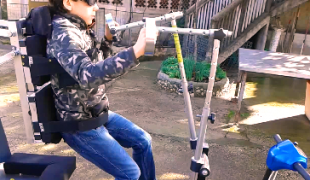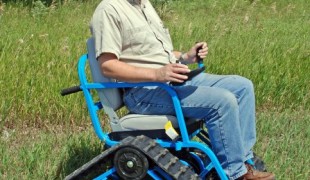- 3259
- 196
- 2
- 2
- 3
- Help Ukraine
About the solution
John Counsell, a World War II survivor, was shot through the back. This made him become a paraplegic. He was satisfied with the manual wheelchairs, but then he realised that quadriplegics would benefit from something more sophisticated.
As a patient and advocate for Canada’s veterans, he requested the National Research Council and George Klein to build a new kind of wheelchair.
George accepted the challenge and ended up considering it the most rewarding project of his career.
He came up with a unique package of technologies including the joystick, tighter turning systems and separate wheel drives that are still features of electric wheelchairs nowadays.
Canadian veterans were provided with these wheelchairs and then there was made an international effort was made to engage manufacturers. This culminated in the formal transfer of the prototype chair to the United States Ambassador to Canada and the head of the U.S. Department of Veterans Affairs with patent-free rights to encourage production in the U.S.
This led to the major wheelchair manufacturing companies had embraced the technology and made it available to disabled civilians in mass.
Adapted from: https://bit.ly/2OGLcJo
This solution shall not include mention to the use of drugs, chemicals or biologicals (including food); invasive devices; offensive, commercial or inherently dangerous content. This solution was not medically validated. Proceed with caution! If you have any doubts, please consult with a health professional.
DISCLAIMER: This story was written by someone who is not the author of the solution, therefore please be advised that, although it was written with the utmost respect for the innovation and the innovator, there can be some incorrect statements. If you find any errors please contact the patient Innovation team via info@patient-innovation.com
-
• Tue, 09/03/2019 - 15:55
The innovation of patience is done for the symbols and all materials for the children. The worth of the essay service is ensured for the components for the individuals. It is done for the severity of the clause for humans.
• Wed, 11/20/2019 - 07:40
-
-
395
-
3
-
6565

I'VE PATENTED A MACHINERY THAT ALLOWS TO PHYSYCALLY IMPAIRED TO WALK :)
WALKING WITH A WALKING AID: Walking with a walking aid
WALKING: Walking
MOVING IN A WHEELCHAIR: Moving using a wheelchair.
Muscular Dystrophy
Muscle Tone Abnormalities
Brain Injury (Abscess, Brain Barrier Defect, Brain Contusion, Brain Hemorrhage, Brain Edema)
Neuromuscular Disorders
Cerebral Palsy
Walking Aid (wheelchair/walker/crutches)
Assistive Daily Life Device (to help ADL)
Difficulty coordinating movements
Stiffness or rigidity (difficulty moving)
Paralysis of the legs and lower body
Muscle weakness
Restoring mobility
Managing Neurological Disorders
Preventing (Vaccination, Protection, Falls, Research/Mapping)
General and Family Medicine
Medical Genetics
Neurology
Orthopedics
Pediatrics
Italy
-
-
-
85
-
0
-
1552

Collaborator Pierluigi Mantovani creates Evolution Devices - solutions that aim to transform Multiple Sclerosis Management
CAREGIVING
BODY BALANCE: Maintaining body balance
STANDING UP: Standing up from a seated position
WALKING: Walking
Multiple Sclerosis
Assistive Daily Life Device (to help ADL)
Walking Aid (wheelchair/walker/crutches)
App (Including when connected with wearable)
AI algorithm
Body-Worn solutions (Clothing, accessories, shoes, sensors...)
Restoring mobility
Regaining sensory function
Managing pain
Promoting self-management
Preserving Organ Function
Managing Neurological Disorders
Maintaining Balance and Mobility
To improve Treatment/Therapy
Preventing (Vaccination, Protection, Falls, Research/Mapping)
Raise awareness
Caregiving Support
General and Family Medicine
Internal Medicine
Medical Genetics
Neurology
Physical Medicine and Rehabilitation
United States
-
-
-
266
-
0
-
4525

Parents create a track-chair for their paralysed son
MOVING IN A WHEELCHAIR: Moving using a wheelchair.
CAREGIVING
Paralysis
Neuromuscular Disorders
Walking Aid (wheelchair/walker/crutches)
Assistive Daily Life Device (to help ADL)
Gait abnormalities (e.g., walking difficulties, unsteady gait)
Difficulty coordinating movements
Stiffness or rigidity (difficulty moving)
Paralysis of the legs and lower body
Muscle weakness
Loss of balance
Promoting inclusivity and social integration
Maintaining Balance and Mobility
Preventing (Vaccination, Protection, Falls, Research/Mapping)
Caregiving Support
Neurology
Neurosurgery
Orthopedics
Rheumatology
United States
-
 en
en
Danielperez123 • Tue, 08/06/2019 - 13:35
Google